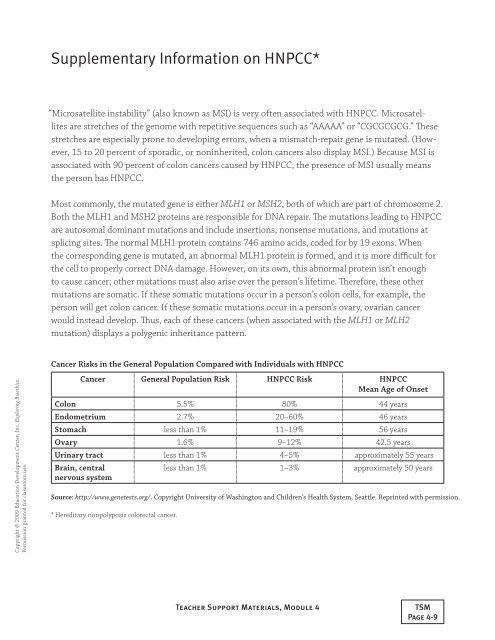Complete Module 4 Teacher Support Materials - NIH Office of ...
Complete Module 4 Teacher Support Materials - NIH Office of ...
Complete Module 4 Teacher Support Materials - NIH Office of ...
Create successful ePaper yourself
Turn your PDF publications into a flip-book with our unique Google optimized e-Paper software.
Supplementary Information on HNPCC*“Microsatellite instability” (also known as MSI) is very <strong>of</strong>ten associated with HNPCC. Microsatellitesare stretches <strong>of</strong> the genome with repetitive sequences such as “AAAAA” or “CGCGCGCG.” Thesestretches are especially prone to developing errors, when a mismatch-repair gene is mutated. (However,15 to 20 percent <strong>of</strong> sporadic, or noninherited, colon cancers also display MSI.) Because MSI isassociated with 90 percent <strong>of</strong> colon cancers caused by HNPCC, the presence <strong>of</strong> MSI usually meansthe person has HNPCC.Most commonly, the mutated gene is either MLH1 or MSH2, both <strong>of</strong> which are part <strong>of</strong> chromosome 2.Both the MLH1 and MSH2 proteins are responsible for DNA repair. The mutations leading to HNPCCare autosomal dominant mutations and include insertions, nonsense mutations, and mutations atsplicing sites. The normal MLH1 protein contains 746 amino acids, coded for by 19 exons. Whenthe corresponding gene is mutated, an abnormal MLH1 protein is formed, and it is more difficult forthe cell to properly correct DNA damage. However, on its own, this abnormal protein isn’t enoughto cause cancer; other mutations must also arise over the person’s lifetime. Therefore, these othermutations are somatic. If these somatic mutations occur in a person’s colon cells, for example, theperson will get colon cancer. If these somatic mutations occur in a person’s ovary, ovarian cancerwould instead develop. Thus, each <strong>of</strong> these cancers (when associated with the MLH1 or MLH2mutation) displays a polygenic inheritance pattern.Cancer Risks in the General Population Compared with Individuals with HNPCCCopyright © 2009 Education Development Center, Inc. Exploring Bioethics.Permission granted for classroom use.Cancer General Population Risk HNPCC Risk HNPCCMean Age <strong>of</strong> OnsetColon 5.5% 80% 44 yearsEndometrium 2.7% 20–60% 46 yearsStomach less than 1% 11–19% 56 yearsOvary 1.6% 9–12% 42.5 yearsUrinary tract less than 1% 4–5% approximately 55 yearsBrain, centralnervous systemless than 1% 1–3% approximately 50 yearsSource: http://www.genetests.org/. Copyright University <strong>of</strong> Washington and Children’s Health System, Seattle. Reprinted with permission.* Hereditary nonpolyposis colorectal cancer.<strong>Teacher</strong> <strong>Support</strong> <strong>Materials</strong>, <strong>Module</strong> 4TSMPage 4-9
















